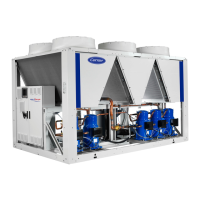53
Table 51 — Troubleshooting
CHILLED FLUID PROOF-OF-FLOW SWITCH OPEN —
After the problem causing the loss of flow has been corrected,
reset is manual by resetting the alarm with the scrolling
marquee.
OPEN 24-V CONTROL CIRCUIT BREAKER(S) — De-
termine the cause of the failure and correct. Reset circuit break-
er(s). Restart is automatic after MBB start-up cycle is
complete.
COOLING LOAD SATISFIED — Unit shuts down when
cooling load has been satisfied. Unit restarts when required to
satisfy leaving fluid temperature set point.
THERMISTOR FAILURE — If a thermistor fails in either an
open or shorted condition, the unit will be shut down. Replace
EWT, or LWT as required. Unit restarts automatically, but must
be reset manually by resetting the alarm with the scrolling
marquee.
ENABLING AND DISABLING COMPRESSORS —
Compressors in the 30MP units can be enabled or disabled in
the controls. To enable or disable a compressor, toggle the
value in the Configuration
SERV menu for each individual
compressor.
COMPRESSOR DISCHARGE CHECK VALVE — A
disk-type check valve in the discharge of the compressor pre-
vents high pressure discharge gas from flowing rapidly back
through the compressor at shutdown. This same check valve
prevents a high to low side bypass in multiple compressor
circuits.
LOW SATURATED SUCTION — Several conditions can
lead to low saturated suction alarms and the chiller controls
have several override modes built in which will attempt to keep
the chiller from shutting down. Low fluid flow, low refrigerant
charge and plugged filter driers are the main causes for this
condition. To avoid permanent damage and potential freezing
of the system, do NOT repeatedly reset these alert and/or alarm
conditions without identifying and correcting the cause(s).
COMPRESSOR SAFETIES — The 30MP units with Com-
fortLink controls include a compressor protection board that
protects the operation of each of the compressors. Each board
senses the presence or absence of current to each compressor.
SYMPTOMS CAUSE REMEDY
Compressor Cycles
Off on Loss of Charge
Loss of charge control. Acting erratically. Repair leak and recharge.
Replace control.
Low refrigerant charge Add refrigerant.
Low suction temperature Raise cooler leaving fluid temperature set point.
Compressor Cycles Off on Out
of Range Condition
Thermistor failure Replace thermistor.
System load was reduced faster than controller could
remove stages
Unit will restart after fluid temperature rises back into the
control band. Avoid rapidly removing system load or
increase loop volume.
Temperature controller deadband setting is too low Raise deadband setting.
Compressor Shuts Down on
High-Pressure Control
High-pressure control acting erratically Replace control.
Noncondensables in system Purge system.
Condenser scaled/dirty (30MPW) Clean condenser.
Fans in remote condensing unit (30MPA only) not operating Repair or replace if defective.
System overcharged with refrigerant Reduce charge.
Unit Operates Too Long
or Continuously
Low refrigerant charge Add refrigerant.
Control contacts fused Replace control.
Air in system Purge system.
Partially plugged or plugged expansion valve or filter drier Clean or replace as needed.
Defective insulation Replace or repair as needed.
Service load Keep doors and windows closed.
Damaged compressor Check compressor and replace if necessary.
Unusual or Loud System
Noises
Piping vibration Support piping as required.
Check for loose pipe connections or damaged compressor
Expansion valve hissing Check refrigerant charge.
Check for plugged liquid line filter drier.
Compressor noisy Replace compressor (worn bearings).
Check for loose compressor holddown bolts.
Operation outside of compressor operating envelope. Con-
sider head pressure control, clean condenser. Check water
flow (cooler and condenser).
Compressor not pumping Advanced scroll temperature protection is active. Determine
high discharge temperature reason.
Compressor Loses Oil Leak in system Repair leak.
Mechanical damage (Failed seals or broken scrolls) Replace compressor.
Oil trapped in line Check piping for oil traps.
Hot Liquid Line Shortage of refrigerant due to leak Repair leak and recharge.
Frosted Liquid Line Restricted filter drier Replace filter drier.
Frosted Suction Line Expansion valve admitting excess refrigerant (note: this is a
normal condition for brine applications)
Replace valve if defective.
Stuck TXV (thermostatic expansion valve) Replace valve if defective.
Freeze-Up Improper charging Make sure a full quantity of fluid is flowing through the cooler
while charging, and suction pressure in cooler is equal to or
greater than pressure corresponding to 32 F (0° C).
System not drained for winter shutdown Recommended that system be filled with an appropriate gly-
col mixture to prevent freezing of pumps and fluid tubing.
Loose thermistor Verify thermistors are fully inserted in wells.
CAUTION
If unit stoppage occurs more than once as a result of any of
the safety devices listed, determine and correct cause
before attempting another restart.

